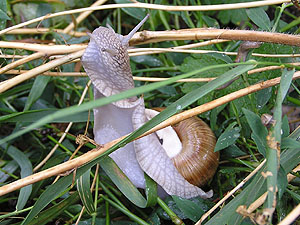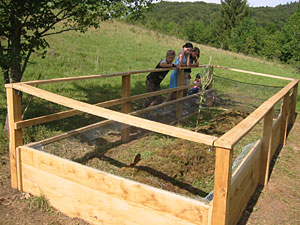
The Roman Snail (Helix pomatia). [RN]
 The Roman Snail (Helix pomatia). [RN] |
Snail cultivation or Heliciculture is a branch of agriculture known since Roman times. In the ancient world snails were called cochlea, like the Latin word for a kind of spoon, which is what their shells were used for. The Roman were very much after the tasty snails, had them picked up in Liguria and fattened in cochlearia - snail gardens, until they could be prepared as food. For example served in milk they were popular because of their stimulating effect, as Pliny and Varro write about the snail.
The Roman Empire's area of influence increasing so did the distribution of snails and snail recipes until into the furthest regions of Europe and the Mediterranean. Snail shells often are found in ancient kitchen waste heaps that are excavated around former Roman settlements. Even today the snail Helix pomatia is called the Roman snail, as it was most probably in Roman times, that it was introduced on the British Isles.
That should not lead to the assumption that the consumption of snails had not a much older history. Today it is though that the common brown garden snail (Cornu aspersum) had already been introduced to the British Isles long before the Romans, in Celtic times, from France. Greeks, Phoenicians and other pre-Roman cultures in the Mediterranean have certainly consumed snails and other molluscs. Sea food in general, but also terrestrial snails are until today a constant part of Mediterranean cuisine.
The Middle Ages brought with them another way of looking at snails and heliciculture. Snails have got the crucial advantage to be neither fish nor meat, so they could be eaten during the time of Lent. Consequently most monasteries also had a snail garden, where the monks could keep the tasty snails, to eat them with an equally monasterial hump of beer.
 Snail trader in Indelhausen, Swabian mountains. |
At that time, though, the monks were not the only people to eat snails. Snails as well were food for the poor. Snails were for free, they could be picked in nature, and they were (and are today) very nutritive and rich. That is probably how snail gardens came into existence in the German region of the Swabian Mountains, from where they have been described until the last century.
In addition to own consumption trade soon was another option. Especially the fat lid snails were sold on the markets as a natural conserve. One or the other hilarious story was apt to arise, for example the story goes that once some farmers set off to the market with a wagon full of lid snails to be sold. On the way to the market they naturally stopped at the one or other pub, which last so long that by the time the farmers finally reached the market, the snails had woken up and left the wagon. Together with trade, of course, also came cultivation. Where for own consumption it was sufficient to pick up the snails, keep them in snail gardens to fatten them and then eat especially the fat lid snails, for a successful trade, snails had to be fatter, tastier and better than all others. From that time came also the idea to feed the snails with a diet of special herbs that gave them an especially fine taste.
There was also a place in that time's medicine for snails. It was well known, that a cure against cough and other breast problems could be produced from snails, as well as a remedy against consumption.
 Historical snail garden built by the Nürtingen UAS as part of the Albschneck project. |
The success of Swabian snail merchants speaks volumes: On the waterway down the Danube River up to 500 tonnes of lid snails in barrels were transported by special transport boats, the Ulm boxes, to Vienna. There the snails were sold on the markets and the way back (600 kilometres at least) was covered on foot, together with the children, inevitable to the famous Viennese charm. There was a roaring trade with snails between Swabia and Vienna until well into the 18th century.
Later the main target of snail trade moved towards Paris, where snails could be transported overland. Even in 1908 the Swabian village of Guttenstein alone sold 4 millions of snails to Paris at a price of 4 to 5 marks per thousand.
While lid snails accompanied Napoleon's columns on their campaigns as natural conserves, the coming up of modern conservation techniques at the beginning of the 20th century put an end to the Swabian snail trade. Today snails are mostly imported from Eastern Europe or even from Africa and Asia.
Snails today are though to be an haute cuisine delicacy. Peasant recipes like snail dumplings, snail sausages or snails with horseradish and cabbage from 18th and 19th century Austria today are forgotten. A proverb from Styria tells, though, that a man was especially capable in the bedchamber, provided he had eaten snails before. This probably should not be forgotten.
But even today there is a future for the trade in snails. In France snails never lost their role as a meal for everyone. In the Germany, Switzerland and Austria - in the South more than in the North - snails win back a certain importance. Rural restaurants in Swabia, but also one or the other star chef rediscovered historical recipes or invented their own. So it happens there are "snails marinated with shrimps on rocket and baked tomatoes" (from the restaurant Krone (the crown) in Nersingen-Unterfahlheim).